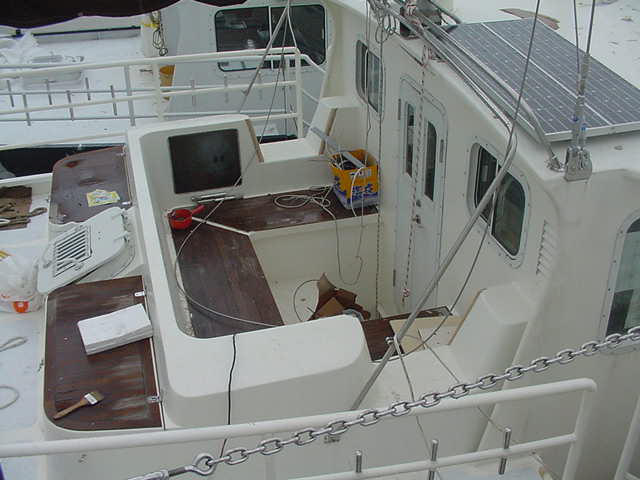11/4//2014 New rig drawings Seahorse 492 drawings
10/28/2014 New 60′ Seahorse DUCK based research/survey vessel
The Seahorse Built Diesel Ducks

The 462 Seahorse DUCK is a spectacular ship
You’ll read in other places on this site how the idea of the DIESEL DUCK boats came about. Briefly, I liked the original so much that I made a few different sizes of them. Some people wanted different sizes again, one thing led to the next, and now there’s this DUCK family.
One of the best things that has happened to them is the involvement of Bill Kimley owner of Seahorse Yachts in China. I don’t remember if a client of mine first approached him or if he approached me with the client, but regardless, he took the 44 made some small changes, and three were sold right off. These three are still some of my favorites, and all three of them made long voyages. He then built a highly modified 48, and a 55 that followed the plans pretty well. You’ll see a section this site devoted to her. Both the 55 and the first 44 now live in the Puget Sound area.
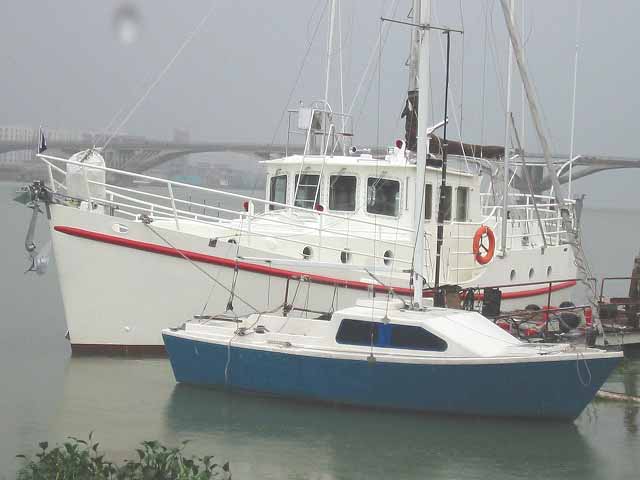
New 60′ Seahorse DUCK based research/survey vessel, the first Seahorse Duck. A modified 44, she and David Katz, her owner, single handed a two year trip from Hong Kong, through the Islands, to San Francisco, Alaska, and then Seattle. She now lives near Pt. Townsend, Washington.

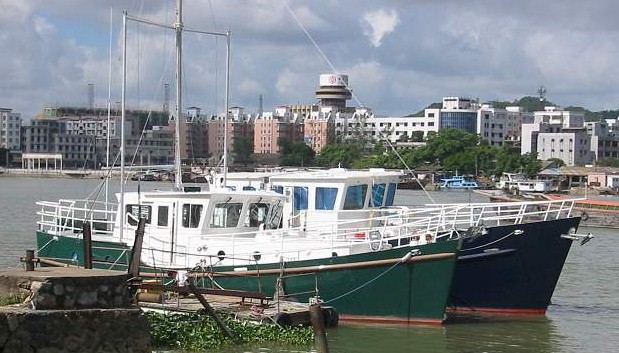 |
Here’s Gorgons DUCK moored next to the 48 Bill built. This boat has traveled extensively and is in Europe at this writing. |
The original three 44 DUCKS left on their own bottom. One went back to his home in Japan. David Katz, a long time single hander, took two years to go through the south Pacific and back to the west coast of the US. And a third is leisurely headed around the world. So far he’ “did” the Red Sea, and the winter of 05 found them in the Filipinos. Here’s a letter Gorgon mailed about the trip to date:
The Red Sea and Suez Canal passage is just a faint blur in my memory. The reason for this is either the arteriosclerotic brain or the fact that the “pot is full” after three months of cruising along the Turkish coast.
Our plan was to do The Red Sea as fast as possible and get to the Mediterranean in time to enjoy a full cruising season. Most sailboats spend one to two months on this trip, ducking in and out of protected anchorages along the western shore. We left Djibouti on April 21, and headed right for the middle; at times close to the shipping lanes. The first four days were great: wind over the stern, averaging 7 kts and 170 miles / day. Then we had to pay our dues: unrelenting strong winds from the NNW, right on the nose, blowing at Beaufort 7 to 9. This lasted for five days and the seas were building to impressive size. Once you are in the middle of the Red Sea, there is no hiding. I had to throttle way down and at times we moved only at a speed of one to two knots. At this speed and these seas I had no choice, but to face the seas head on. The boat would have been rolled badly at any other angle. Pounding into the sea, our strong Nomad sounded like a thin tin can! Once, the captain of a large tanker that was passing close to our boat, called, asking if he could be of any help. He kept asking whether he could do anything for us — this got us really worried! On the 9th day things calmed down and we tied up to a mooring buoy in front of the “Suez Yacht Club” in the evening of April 29.
The Suez Canal passage is a two day affair and one needs to engage an “agent”, who will make the necessary arrangement. The boat needs to be ad measured and inspected and the hands of everybody involved need to be lubricated with US Dollars. There is somebody constantly rowing about in the anchorage asking for Cigarettes (Marlboro) and money — usually making a “hard landing” with the old wooden skiff if one does not oblige. Nomad suffered a few scars here. I have seen some of these guys jumping up and down, repeatedly banging into a nice yacht, and screaming ” Allah will punish you!”, if the owner did not oblige to their requests. By the way, these people all work for the “agent”.
The first stop is in Ismailia. After Suez this is a pleasant surprise. There is a nice marina with clean facilities and friendly staff. One can stay for just one night or longer, arrangements for the pilot are made when one is ready to leave. We left Ismailia on May 8, heading for Port Said. Our pilot was a quiet, friendly chap. Shortly before the pilot boat took him off in Port Said he requested his “gift”. I gave him cigarettes and more Dollars than the “usual” rate, but he was suddenly not very happy — he also wanted a T-shirt. Since I did not have one for his size — he was a big fellow — He left rather brusquely. We did not stop in Port Said — a derelict place, I was told — and sailed straight to Cyprus, which we reached on May 10.
The Canal itself is interesting, but also monotonous. Desert on the left side and desert on the right side. Being passed — almost within reach — by a VERY large container ship is exciting, however.
We are now back in Finike, Turkey. Since our departure from Phuket, Thailand we have covered about 7000 miles. Considering our fuel consumption, the boat traveled 4.2 miles / Gal. ( 1.1 miles / Liter ) or used 0.24 Gal. / mile ( 0.9 Liters / mile ). Average speed: 6.3 kts @ RPM 1300 to ( mostly )1400+.
Best wishes,
Gorgon
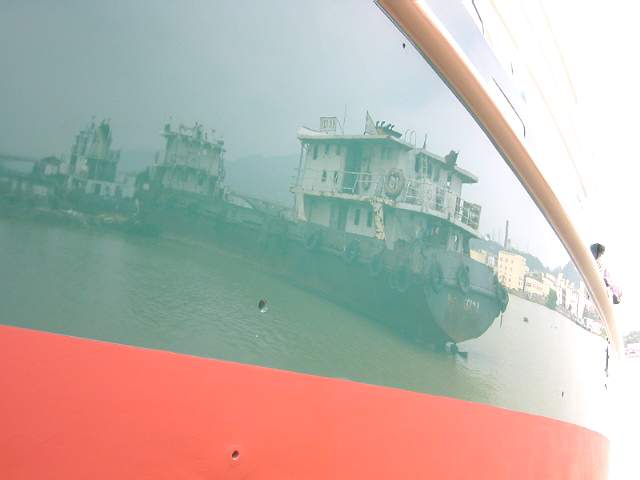
Between Bill’s ideas and some of his customer’s ideas a new kind of DUCK came about. Ideas I never even thought of started appearing. That’s why I say NO design appears out of a vacuum. ALL successful designs are a blend of ideas, many times going back into previous centuries. Any designer who claims otherwise is just a bit full of themselves!
For instance, the passageway connecting the front and the back half of the boat. I automatically separated the hull into two parts, with a separate engine room in the middle, with the fuel tanks on each side of the engine. This was a waste of space. By putting a passageway down one side of the engine it still leaves a very large engine room, especially by sailboat standards. That feature allows you to avoid a separate stairway from the house down to the aft cabin. And best of all, it gives a good place for the galley, which frees up the entire front half of the boat for living space. The tanks go under the forward cabin sole except in some of the wooden hulls. The wood framework takes a lot of space and we often still need some tankage in the engine room.
Seahorse and I worked up the 462. This boat had the radical (for me; it’s common in the industry) of a “step” transom. The transom is actually several feet forward of where it would normally be. It drops vertical to a line parallel to the chine, then goes aft to the chine, making a platform and a “swim step” that is actually part of the hull. If the boat had a normal stern she’d be close to 49 foot long. But as is, she is around 46 on deck but close to 48 over all. To make the stern look a bit less blocky in profile, “wings” were added. These are simply extensions of the side plate. They serve as side rails perhaps, but nothing else other than smoothing the profile appearance. The photo below shows how the stern works.
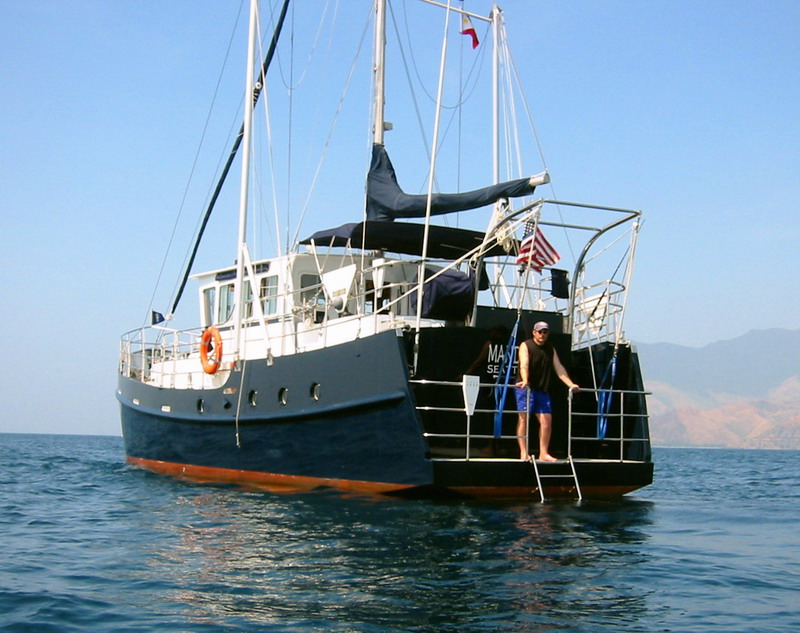
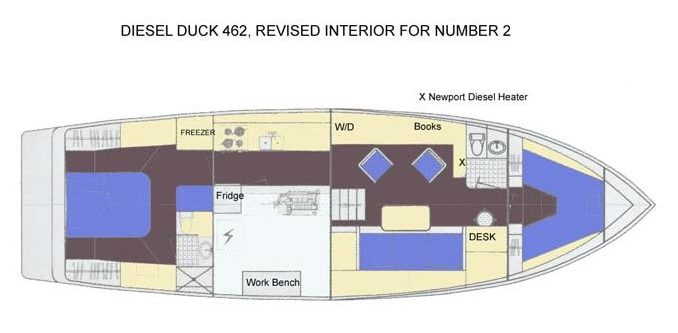
Bill’s interior on the second 462 shows the galley in the Passage along side the engine room.
As the photos show, this is a very comfortable cruising interior.

By now, Bill was so busy he had to stop doing the custom building that he started off the his involvement in the DUCKS with. He’s very “hands on” and personally worked out all of the interior ideas on his company’s boats. There simply wasn’t the time to do that with a changing variety and he instead concentrated on making the 462 as comfortable and well laid out as possible. The results are obvious. Just watch the video link of the comments from folks at the ’07 Trawlerfest where a 462 was voted “Best Of Show” by the attendees. Here it is! The 462 Diesel Duck Video: Passagemaker Magazine’s Video of the 2007 “People’s Choice” award! Here’s some interior shots from the 462.
 |
The Passageway Galley is spacious and even though it is out of the way it is still part of the living area. |
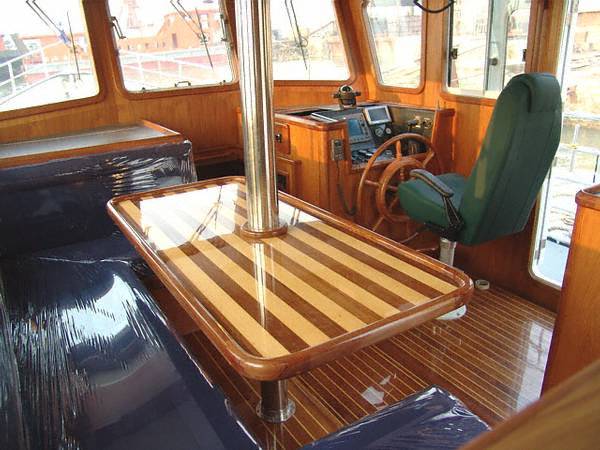 |
Spacious wheelhouse with excellent visibility. |
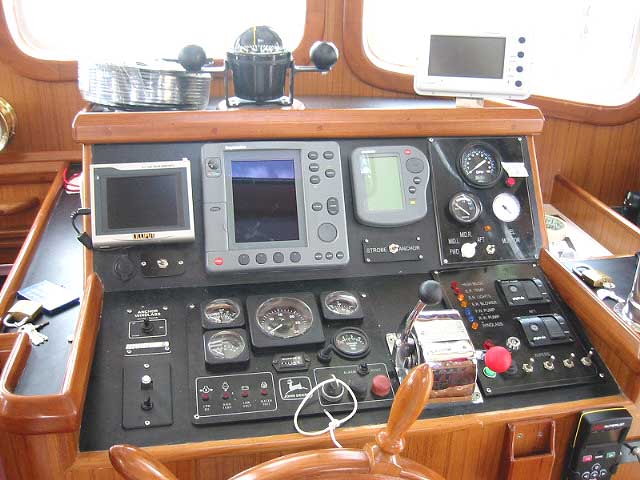 |
Here’s the standard “dash” of the 462. |
 Setting up the Outriggers |
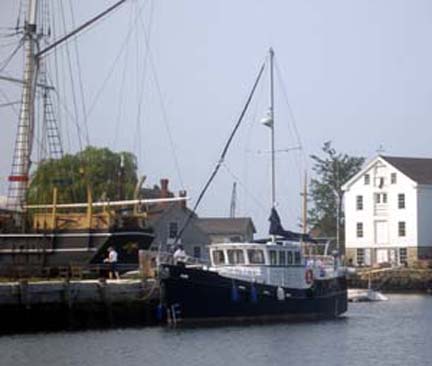 |

